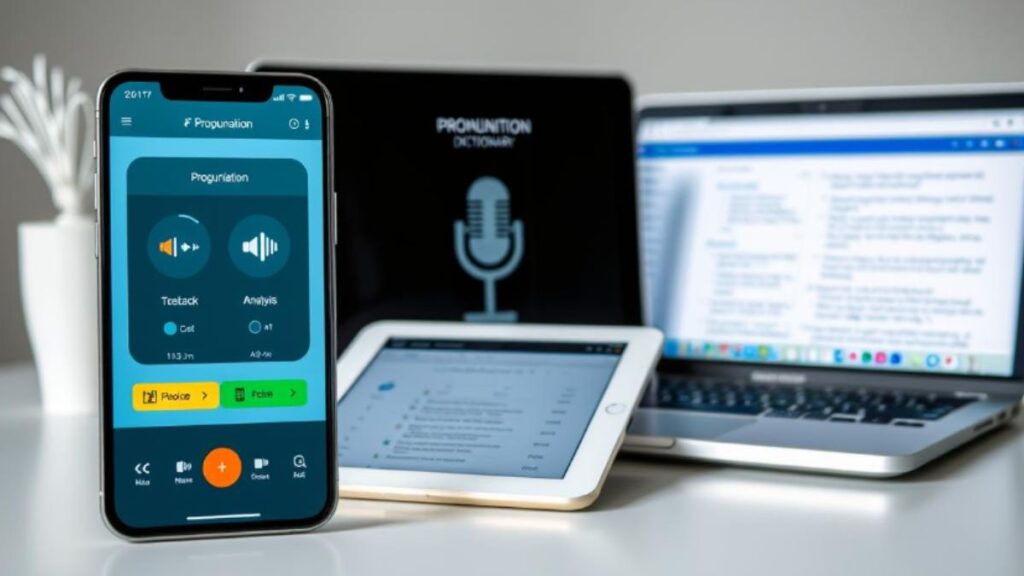Introduction
Mastering clear and rhythmic pronunciation is crucial for intermediate learners aiming to enhance their communication skills. At the B1-B2 level, learners are refining their ability to express themselves effectively.

Through targeted English Pronunciation Exercises for Intermediate Learners, students can improve their clarity and rhythm, becoming more confident speakers. This introduction outlines the benefits and expectations of the exercises provided in this article.
Key Takeaways
- Improve clarity and rhythm in pronunciation.
- Enhance communication skills at the B1-B2 level.
- Boost confidence in speaking through targeted exercises.
- Refine expression and intonation.
- Achieve more effective communication.
Why Pronunciation Matters at the Intermediate Level
Intermediate learners often realize that pronunciation is the distinguishing factor between basic and refined communication. As learners progress in their language journey, the focus shifts from basic comprehension to more nuanced aspects of language, such as clarity, rhythm, and intonation.
The Shift from Basic to Refined Communication
At the intermediate level, learners are expected to convey their thoughts more effectively and understand various spoken dialects. Pronunciation plays a crucial role in this transition, enabling learners to express themselves with greater clarity and confidence. Clear pronunciation helps in avoiding misunderstandings and ensures that the message is conveyed as intended.
How Better Pronunciation Impacts Listening Comprehension
Better pronunciation not only enhances speaking skills but also significantly improves listening comprehension. When learners can pronounce words correctly, they are more likely to recognize these words when they are spoken by others. This, in turn, improves their overall comprehension and ability to engage in conversations effectively.
| Benefits of Improved Pronunciation | Impact on Communication |
|---|---|
| Enhanced Clarity | Reduces misunderstandings |
| Better Listening Comprehension | Improves overall communication effectiveness |
| Increased Confidence | Encourages more active participation in conversations |
Assessing Your Current Pronunciation Skills
Assessing your current pronunciation skills is essential for intermediate learners aiming to enhance their clarity and rhythm in English. This assessment serves as a foundation for targeted improvement, allowing learners to focus on specific areas that need refinement.
Self-Recording Techniques
One effective method for assessing pronunciation is through self-recording. By recording yourself speaking, you can identify areas that require improvement. To do this effectively:
- Read a passage or speak on a topic for about 2-3 minutes.
- Record your voice using a smartphone app or digital recorder.
- Listen to the recording, paying close attention to your pronunciation, intonation, and rhythm.
Tip: Compare your recording with a native speaker’s recording on the same topic to highlight differences.
Common Pronunciation Challenges for B1-B2 Learners
B1-B2 learners often face specific challenges, including difficulties with certain vowel sounds, consonant clusters, and intonation patterns. A common issue is the tendency to apply the pronunciation rules of their first language to English.
-------- Continua após a publicidade --------
First Language Interference Patterns
First language interference can significantly impact English pronunciation. For example, learners whose native language does not have certain sounds present in English may struggle to pronounce them correctly. Understanding these patterns can help in creating a more focused practice plan.
| Challenge | Description | Example |
|---|---|---|
| Vowel Sound Differences | Difficulty with English vowel sounds not present in the learner’s native language. | Learners may struggle with the “short a” sound in “cat.” |
| Consonant Clusters | Trouble pronouncing groups of consonants together. | Struggling with the “str” sound in “street.” |
| Intonation Patterns | Challenges with the rise and fall of pitch when speaking. | Difficulty with rising intonation in questions. |
Understanding American English Phonetics
To improve pronunciation, it’s essential to grasp the fundamentals of American English phonetics. American English phonetics involves the study of the sound system of American English, which is crucial for effective communication.
The International Phonetic Alphabet (IPA) for American English
The International Phonetic Alphabet (IPA) is a standardized system used to represent the sounds of spoken languages in a unique and consistent way. For American English, the IPA provides a valuable tool for learners to accurately pronounce words by transcribing them into phonetic symbols.
The IPA chart for American English includes a range of vowel and consonant symbols. Understanding these symbols can help learners improve their pronunciation by providing a precise representation of the sounds they need to produce.
Key Differences Between American and Other English Varieties
American English has distinct phonetic features that differentiate it from other varieties of English, such as British or Australian English. One key difference lies in the pronunciation of certain vowels and diphthongs.
For instance, the vowel sound in “cot” and “caught” is often the same in American English (a phenomenon known as the cot-caught merger), whereas in some other varieties, these words have distinct vowel sounds.
Resources for Learning American Phonetic Symbols
Several resources are available for learners to improve their understanding and use of American phonetic symbols. Online dictionaries like Merriam-Webster and Cambridge Dictionary provide IPA transcriptions for words, helping learners to check their pronunciation.
- Online courses and pronunciation guides offer detailed explanations and practice exercises.
- Language learning apps often include phonetics lessons and quizzes.
| Resource | Description | IPA Support |
|---|---|---|
| Merriam-Webster Dictionary | Provides IPA transcriptions for American English words | Yes |
| Cambridge Dictionary | Offers IPA transcriptions for both British and American English | Yes |
| Forvo Pronunciation Guide | A platform where users can share and listen to pronunciations | No, but provides audio |
By leveraging these resources and practicing with the IPA, learners can significantly improve their pronunciation of American English.
Mastering Vowel Sounds in American English
To improve pronunciation, it’s essential to understand the nuances of vowel sounds in American English. Vowel sounds are the core of spoken language, and mastering them can significantly enhance clarity and comprehension.
Short vs. Long Vowels
American English distinguishes between short and long vowels, a distinction that can change the meaning of words. For instance, the words “sit” and “seat” differ only in the length of their vowel sound. Practicing short and long vowels can help learners avoid confusion and improve their pronunciation.
Short vowels are typically found in words like “cat,” “sit,” and “cut.” Long vowels, on the other hand, are found in words like “cake,” “seat,” and “cue.” Understanding the difference between these vowels is crucial for accurate pronunciation.
Diphthongs and Triphthongs
Diphthongs and triphthongs are complex vowel sounds that involve a glide from one vowel sound to another within the same syllable. Diphthongs are common in American English, as seen in words like “boy” (oi) and “out” (ou). Triphthongs, though less common, also play a significant role, particularly in certain regional accents.
Practicing diphthongs and triphthongs can be challenging but is essential for achieving a natural flow in speech. Exercises that focus on these complex vowel sounds can help learners become more comfortable with their pronunciation.
Practical Vowel Exercises
Effective pronunciation practice involves a variety of exercises. One useful technique is minimal pairs practice, which involves pronouncing words that differ by only one phoneme, such as “pat” and “bat.”
Minimal Pairs Practice
Minimal pairs practice is an effective way to improve vowel pronunciation. By focusing on the differences between similar words, learners can develop a more nuanced understanding of vowel sounds.
| Minimal Pair | Pronunciation Focus |
|---|---|
| sit / seat | Short vs. Long ‘i’ |
| cat / cut | Different Short Vowels |
| boy / buy | Diphthong Practice |
By incorporating these exercises into their practice routine, learners can significantly improve their mastery of vowel sounds in American English.
Perfecting Consonant Pronunciation
Enhancing consonant pronunciation skills can significantly improve overall English speaking proficiency. Consonant pronunciation is a critical aspect of clear and effective communication in English.
Problematic Consonant Pairs
Certain consonant pairs are notoriously difficult for learners, including th, r/l, and v/w. Mastering these sounds requires practice and dedication. For instance, the “th” sound, as in “this” and “that,” is often challenging due to its unique tongue and lip positioning.
To overcome these challenges, it’s essential to practice words that contain these sounds. For example, “right” and “light” for the r/l distinction, and “vine” and “wine” for v/w.
Consonant Clusters
Consonant clusters, where two or more consonants appear together, can be particularly tricky. Examples include “black,” “stretch,” and “strengths.” Practicing these clusters can help improve pronunciation.
- Start with simple clusters and gradually move to more complex ones.
- Record yourself to identify areas for improvement.
- Listen to native speakers to mimic their pronunciation.
Daily Consonant Drills
Daily practice is crucial for improving consonant pronunciation. Simple drills can be incorporated into daily routines, such as repeating words with specific consonant sounds or clusters.
Tongue Twisters for Precision
Tongue twisters are an engaging way to practice consonant pronunciation. Examples include “Six sick squirrels singing silly songs” for the “s” and “sh” sounds, and “Percy the python perpetually puckered up a plethora of pickled plums” for the “p” sound.
| Sound | Tongue Twister |
|---|---|
| s/sh | Six sick squirrels singing silly songs |
| p | Percy the python perpetually puckered up a plethora of pickled plums |
| r/l | A red lorry, a little rabbit, and a lively lizard laughed loudly |
English Pronunciation Exercises for Word Stress
To enhance pronunciation, it’s essential to understand and practice word stress correctly. Word stress refers to the emphasis placed on a particular syllable in a word, which can significantly affect its meaning and clarity.
Rules for Word Stress in English
English has several rules that govern word stress, although there are exceptions. Generally, stress falls on the penultimate syllable in words ending in -ic, -tion, and -sion. For words ending in -ate, the stress usually falls on the third syllable from the end. Understanding these rules can help learners improve their pronunciation.
- Words ending in -ic (e.g., historic): Stress on the penultimate syllable.
- Words ending in -tion or -sion (e.g., education, decision): Stress on the penultimate syllable.
- Words ending in -ate (e.g., automate): Stress on the third syllable from the end.
Stress Patterns in Multi-syllable Words
Multi-syllable words can be challenging due to their complex stress patterns. Generally, the stress pattern depends on the word’s suffix, prefix, or its root word. For instance, the word “unpredictable” has its primary stress on the third syllable (pre-).
Examples of multi-syllable words and their stress patterns:
- Com-pu-ter: Stress on the second syllable.
- In-for-ma-tion: Stress on the third syllable.
- Un-be-lievable: Stress on the third syllable.
Word Stress Practice Activities
Effective practice activities are crucial for mastering word stress. Here are some techniques:
- Repeating words after a model, either a teacher or a recording.
- Recording oneself and comparing with the correct pronunciation.
- Using clapping or tapping to mark stressed syllables.
Clapping and Tapping Techniques
Clapping or tapping along with the stressed syllables can help learners internalize the rhythm of English words. For example, for the word “banana” (ba-NA-na), you would clap on the second syllable.
Practicing with clapping or tapping:
- Computer: com-PU-ter.
- Information: in-for-MA-tion.
By incorporating these exercises into daily practice, learners can significantly improve their word stress and overall pronunciation.
Sentence Rhythm and Stress Patterns
Mastering sentence rhythm and stress is essential for improving pronunciation and overall fluency in English. Sentence rhythm refers to the pattern of stressed and unstressed syllables in a sentence, which creates a natural flow. Understanding and practicing sentence stress patterns can significantly enhance a learner’s ability to communicate effectively.
Content Words vs. Function Words
In English, words are categorized into content words and function words. Content words, such as nouns, verbs, and adjectives, carry the main meaning of a sentence and are typically stressed. On the other hand, function words, including prepositions, conjunctions, and auxiliary verbs, have a grammatical role and are usually unstressed.
Sentence Stress Exercises
To practice sentence stress, learners can start by identifying content and function words in sentences. For example, in the sentence “She is going to the store,” the words “going” and “store” are content words and should be stressed, while “is,” “to,” and “the” are function words and remain unstressed.
- Read sentences aloud, emphasizing content words.
- Record yourself to identify areas for improvement.
- Practice with different sentence structures to become more comfortable with varying stress patterns.
Rhythm Practice with Jazz Chants
Jazz chants are an engaging way to practice the rhythm of English. They involve repetitive phrases and emphasize the natural rhythm of the language. By practicing jazz chants, learners can improve their ability to recognize and reproduce the stress patterns of English.
| Exercise Type | Description | Benefit |
|---|---|---|
| Sentence Stress | Identify and stress content words | Improves clarity and comprehension |
| Jazz Chants | Practice repetitive phrases with natural rhythm | Enhances rhythm recognition and reproduction |
| Recording | Record yourself reading sentences aloud | Helps identify areas for improvement |
Mastering Intonation Patterns
Intonation patterns play a significant role in conveying meaning and context in spoken English. Mastering these patterns is essential for effective communication, as they can significantly alter the interpretation of a message.
Rising and Falling Intonation
Rising intonation is typically used in yes/no questions, while falling intonation is used in statements and wh-questions. For instance, the sentence “You’re going?” with rising intonation indicates a question, whereas “You’re going.” with falling intonation is a statement.
To practice, try recording yourself and listen to the intonation patterns. You can also use online resources to improve your skills.
Question Intonation
Question intonation is crucial for distinguishing between questions and statements. In American English, yes/no questions usually end with a rising intonation, while wh-questions typically end with a falling intonation.
Expressing Emotions Through Intonation
Intonation can convey a range of emotions, from excitement and surprise to boredom and sarcasm. For example, saying “Oh, great” with a rising intonation can express sarcasm, while a falling intonation can indicate genuine enthusiasm.
Shadowing Exercises with Native Speakers
One effective way to practice intonation is through shadowing exercises with native speakers. Listen to a native speaker and try to mimic their intonation patterns. This can be done with podcasts, TV shows, or even social media videos.
| Intonation Pattern | Example | Emotion/Meaning |
|---|---|---|
| Rising | “Really?” | Surprise/Questioning |
| Falling | “Really.” | Statement/Assertion |
| Rising-Falling | “Oh, great.” | Sarcasm/Disapproval |
By mastering intonation patterns and practicing with shadowing exercises, learners can significantly improve their pronunciation and communication skills in English.
Connected Speech Phenomena
To sound more natural in English, it’s vital to understand and practice connected speech phenomena. Connected speech refers to the way words are pronounced in a continuous flow, rather than individually. Mastering these phenomena is crucial for improving pronunciation and achieving a more natural speech pattern.
Linking, Assimilation, and Elision
Connected speech involves several key phenomena: linking, assimilation, and elision. Linking refers to the process of connecting words together smoothly, often by changing the pronunciation of the final consonant of one word and the initial vowel of the next. For example, “pick up” sounds like “pi-kup.”
Assimilation occurs when a sound changes to become more like a neighboring sound. For instance, in “handbag,” the “d” sound often assimilates to an “b” sound, making it sound like “hambag.”
Elision involves the omission of sounds, typically vowels or consonants, in rapid speech. An example is “comfortable” being pronounced as “comf-table.”

Weak Forms and Contractions
Another important aspect of connected speech is the use of weak forms and contractions. Weak forms refer to the reduced pronunciation of function words like “the,” “a,” “of,” etc., when they appear in unstressed positions. For example, “the” is pronounced as /ðə/ instead of /ðiː/.
Contractions are shortened forms of words or phrases, often with an apostrophe replacing missing letters. Examples include “don’t” (do not), “won’t” (will not), and “it’s” (it is).
Practical Exercises for Connected Speech
To practice connected speech phenomena, try the following exercises:
- Record yourself speaking and listen for areas where you can improve linking, assimilation, and elision.
- Practice repeating phrases with weak forms and contractions to become more comfortable with their pronunciation.
- Engage in conversations with native speakers or language exchange partners, focusing on using connected speech naturally.
By incorporating these exercises into your daily practice, you’ll be able to improve your pronunciation and achieve a more natural speech pattern.
Regional American Accents and Dialects
American English is characterized by its rich variety of regional accents and dialects. This diversity is a result of historical, cultural, and geographical factors that have shaped the way people communicate across different regions.
The United States is a vast country with various regional identities, each with its unique accent and dialect. Understanding these variations is essential for effective communication, especially in professional and social contexts.
General American vs. Regional Variations
General American English is often considered the standard or neutral accent, widely used in media and official contexts. However, regional variations are just as important, as they reflect local cultures and histories.
Key differences between General American and regional variations include:
- Pronunciation of vowels and consonants
- Stress patterns and intonation
- Vocabulary and idiomatic expressions
Key Features of Major American Dialects
Major American dialects include New England, Southern, Midwestern, and Western dialects, each with distinct features.
| Dialect | Key Features |
|---|---|
| New England | Non-rhoticity (dropping ‘r’ sounds), distinct short ‘a’ pronunciation |
| Southern | Drawling intonation, vowel shifts (e.g., “I” sounds like “ah”) |
| Midwestern | Neutral vowel sounds, relaxed pronunciation |
Exposure Exercises for Accent Awareness
To improve pronunciation awareness, it’s essential to expose yourself to various American accents and dialects. Here are some exercises:
- Listen to podcasts or audiobooks from different regions
- Watch movies or TV shows set in various parts of the United States
- Engage in conversations with people from different regional backgrounds
By actively engaging with different accents and dialects, learners can enhance their pronunciation awareness and improve their overall communication skills.
Professional Communication Pronunciation
Mastering professional pronunciation is essential for success in job interviews, presentations, and daily interactions. In professional settings, clear and accurate pronunciation can significantly impact one’s credibility and confidence.
Pronunciation for Job Interviews and Presentations is a critical aspect of professional communication. During job interviews, for instance, how you pronounce certain words can affect the interviewer’s perception of your qualifications and professionalism. Similarly, in presentations, clear pronunciation helps convey your message more effectively to the audience.
Pronunciation for Job Interviews and Presentations
In job interviews and presentations, it’s not just what you say but how you say it that matters. Practicing pronunciation can help reduce anxiety and boost confidence. For example, focusing on correctly pronouncing industry-specific terms can make a significant difference.
“The way we speak is a reflection of who we are and how we wish to be perceived.”
— Deborah Tannen, The Argument Culture
Industry-Specific Terminology
Different industries have their own set of terminologies that are crucial to master for effective communication. For instance, in the medical field, terms like “hypertension” and “hyperglycemia” need to be pronounced correctly.
| Industry | Terminology | Pronunciation |
|---|---|---|
| Medical | Hypertension | high-per-TEN-shun |
| Finance | Amortization | am-or-tie-ZAY-shun |
| Technology | Algorithm | AL-go-rith-um |
Formal vs. Casual Pronunciation Styles
Understanding the difference between formal and casual pronunciation styles is vital in professional communication. Formal pronunciation is typically used in professional settings, such as presentations and interviews, while casual pronunciation is more suitable for everyday conversations.
For example, in formal settings, it’s more appropriate to use full pronunciation of words, whereas in casual conversations, contractions and relaxed pronunciation are common.
In conclusion, mastering professional pronunciation is key to effective communication in the workplace. By focusing on job interviews, presentations, industry-specific terminology, and appropriate pronunciation styles, individuals can enhance their professional image and achieve greater success.
Digital Tools and Resources for Pronunciation Practice
The internet is replete with resources designed to help learners improve their English pronunciation. In today’s digital landscape, learners can access a wide array of tools to enhance their pronunciation skills.

Pronunciation Apps and Websites
Several apps and websites offer comprehensive pronunciation practice. Apps like Duolingo and Babbel provide interactive exercises, while websites such as Forvo and Howjsay offer audio pronunciations of words.
YouTube Channels for Pronunciation Practice
YouTube channels like EnglishClass101 and Rachel’s English are invaluable resources. They offer video lessons that focus on pronunciation techniques, intonation, and rhythm.
Speech Recognition Technology
Speech recognition technology is another powerful tool. Google’s Speech Recognition and Microsoft’s Azure Speech Services can analyze and correct pronunciation in real-time, providing immediate feedback.
“The key to improving pronunciation lies in consistent practice and exposure to the language.”
By leveraging these digital tools and resources, learners can significantly enhance their pronunciation skills.
Creating a Personalized Pronunciation Improvement Plan
Developing a personalized pronunciation improvement plan is crucial for intermediate learners to achieve clarity and rhythm in their speech. A tailored approach allows learners to focus on their specific needs and goals.
To start, it’s essential to set realistic goals. This involves identifying areas that need improvement and setting achievable targets. For instance, a learner might aim to master a specific vowel sound or improve their intonation in questions.
Setting Realistic Goals
When setting goals, consider your current level and what you want to achieve. Break down larger goals into smaller, manageable tasks. For example, if you struggle with the “th” sound, your goal might be to correctly pronounce words like “this” and “that” within a week.
Tracking Progress
Tracking your progress is vital to staying motivated. Use a journal or an app to record your pronunciation practice. Regularly review your recordings to identify improvements and areas that still need work.
Incorporating Pronunciation into Daily Practice
Incorporating pronunciation practice into your daily routine can be simple and effective. Here are some tips:
- Listen to English media daily, paying attention to pronunciation.
- Practice speaking with a language exchange partner or tutor.
- Use pronunciation apps during your commute or breaks.
| Practice Activity | Frequency | Goal |
|---|---|---|
| Listening to English media | Daily | Improve intonation |
| Speaking with a language exchange partner | 3 times a week | Enhance fluency |
| Using pronunciation apps | Daily | Master specific sounds |
By following these steps and staying committed, learners can make significant improvements in their pronunciation. Remember, the key is consistent practice and a willingness to adapt your plan as needed.
🗣️ If you’re still working on mastering the basics, make sure to check out our beginner-friendly pronunciation guide, packed with simple rules and activities to help you speak more clearly from A1 to A2.
Conclusion: Your Path to Pronunciation Mastery
Mastering English pronunciation is a journey that requires dedication and consistent practice. By understanding the nuances of American English phonetics, practicing vowel and consonant sounds, and refining word stress and sentence rhythm, learners can significantly improve their clarity and confidence in communication.
To achieve Pronunciation Mastery, it’s essential to stay on your Learning Path and continually assess and adjust your practice routine. Incorporating digital tools and resources into your daily practice can help maintain Continuous Improvement in your pronunciation skills.
As you continue on your path to pronunciation mastery, remember that every step forward, no matter how small, brings you closer to your goal. Stay motivated, practice regularly, and you’ll see significant improvements over time.
FAQ
What are the benefits of improving English pronunciation for intermediate learners?
Improving English pronunciation can enhance clarity and rhythm, leading to more effective communication. It can also boost confidence in speaking and listening comprehension.
How can I assess my current pronunciation skills?
You can assess your pronunciation skills by recording yourself speaking and comparing it with native speakers. Identifying areas of improvement can help you focus on specific sounds or intonation patterns.
What is the International Phonetic Alphabet (IPA), and how can it help me?
The IPA is a standardized system representing the sounds of spoken languages in a unique and consistent way. Using the IPA can help you learn and practice the correct pronunciation of English words.
What are some common challenges for B1-B2 learners when it comes to pronunciation?
Common challenges include mastering vowel sounds, consonant clusters, and intonation patterns. First language interference can also affect pronunciation.
How can I practice pronunciation outside of language classes?
You can practice pronunciation by listening to native speakers, using pronunciation apps, and recording yourself. Regular practice with digital tools and resources can be beneficial.
What is the difference between General American and other American dialects?
General American is a neutral dialect often used in media and education, while other dialects have distinct features and variations. Exposure to different dialects can enhance accent awareness.
How can I improve my pronunciation for professional communication?
Focusing on clear articulation, correct intonation, and industry-specific terminology can improve your pronunciation for professional settings like job interviews and presentations.
What digital tools are available for pronunciation practice?
There are various apps, websites, and YouTube channels dedicated to pronunciation practice. Speech recognition technology can also provide feedback on your pronunciation.
How can I create a personalized plan to improve my pronunciation?
Setting realistic goals, tracking progress, and incorporating pronunciation practice into your daily routine can help you improve your pronunciation effectively.








1 thought on “English Pronunciation Exercises for Intermediate Learners: Improve Clarity and Rhythm (B1–B2)”